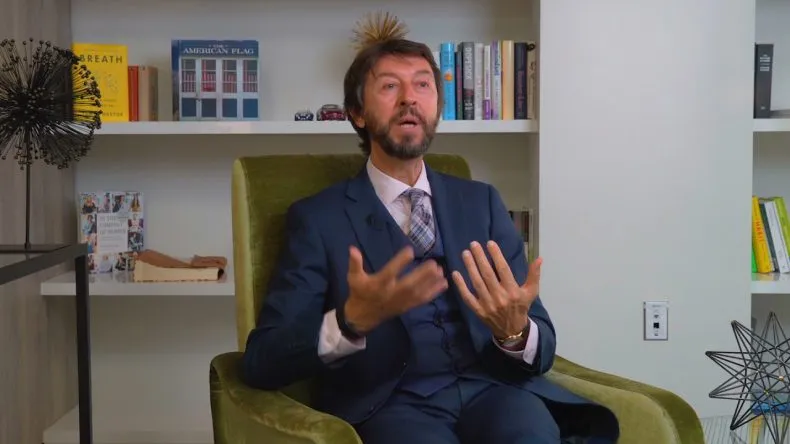Therapy and medication are standard practices for those with chronic pain. However, medication can sometimes have adverse effects, and therapy on its own is not always helpful.
- What Is Transcranial Magnetic Stimulation For Chronic Pain
- How Does Tms Help Treat Chronic Pain
- How Does Tms Work
- Types Of Chronic Pain Tms Can Treat
- The Effectiveness Of Tms In Treating Chronic Pain
- What Is Tms Used For
- What Is Chronic Pain
- Clinical Trial One
- Clinical Trial Two
- Side Effects Of Tms
- What To Expect During A Tms Session For Chronic Pain
- How To Prepare For A Tms Session
- How Much Does Tms Cost
- How Long Do Tms Sessions Last
- Where Can You Receive Tms Treatment
- Begin Your Journey To Wellness Today With GIA Miami
The solution? Brain stimulation therapies, including electroconvulsive therapy (ECT) and transcranial magnetic stimulation (TMS), are starting to gain more traction in the medical field, often being used to alleviate pain or symptoms of depression.
ECT is reserved for severe mental health conditions, like mania or treatment-resistant depression, while TMS treatment is used in a wider variety of medical settings.
What Is Transcranial Magnetic Stimulation for chronic Pain?
The terms transcranial magnetic stimulation and repetitive transcranial magnetic stimulation (rTMS) are frequently used interchangeably. The only difference between the two terms is that repetitive TMS refers to a regular ongoing treatment plan. In contrast, TMS on its own can refer to anything from a few sessions to a complete treatment plan.
A Food and Drug Administration (FDA) approved form of treatment for chronic pain syndrome and depression, TMS is a non-invasive procedure that uses electromagnetic pulses to produce high-frequency stimulation in the motor cortex (the part of the brain that regulates mood and emotion).
This deep stimulation triggers nerve cells in the brain, essentially resetting the system.
How Does TMS Help Treat Chronic Pain?
TMS for chronic pain works by stimulating the primary motor cortex. This cortical stimulation leads to a significant reduction in pain. Though transcranial magnetic stimulation cannot treat chronic pain, it can help manage conditions such as chronic pain syndrome and chronic neuropathic pain, bringing about significant pain relief.
Electromagnetic pulses stimulate nerve pathways in the dorsolateral prefrontal cortex, reducing pain intensity by modulating cortical excitability in the parietal lobe (the part of the brain responsible for pain modulation).
How Does TMS Work?
Transcranial magnetic stimulation may sound scary, but it is very safe and virtually painless. TMS treatment works by triggering nerve cells in the primary motor cortex and dorsolateral prefrontal cortex (the part of the brain responsible for mood regulation).
This motor cortex stimulation delivers magnetic pulses to brain structures, helping to regulate emotions and ease depressive symptoms. This is not the only purpose of TMS, though. It is also used to assist in pain relief and alleviate pain intensity.
In some cases, repetitive transcranial magnetic stimulation is also used in cases of treatment-resistant depression or instances where medication and therapy do not produce any noticeable improvements.
Related: TMS Therapy for Schizophrenia
Types of Chronic Pain TMS Can Treat
Transcranial magnetic stimulation can treat a range of chronic pain conditions, including:
- Chronic pain syndrome (pain that lingers long after an accident, injury, or illness)
- Chronic neuropathic pain (nerve damage, post-shingles neuroglia, and carpal tunnel syndrome)
- Fibromyalgia
- IBS
- Back pain
TMS for chronic pain helps deliver pain relief through magnetic stimulation of brain structures and nerve pathways, inhibiting the sense of pain and leading to significant pain reduction. As noted above, unlike TMS for depression, this pain improvement is not brought on by triggering nerve cells in the motor cortex. Instead, it is caused by regulating a client’s cortical excitability.
Treating chronic pain is not always straightforward, but transcranial magnetic stimulation presents a drug-free method free from side effects and discomfort.
The Effectiveness of TMS in Treating Chronic Pain
TMS for chronic pain is an effective and welcome alternative to more traditional chronic pain management methods. Though clients can utilize medication and therapy, these techniques are often limited in their ability to control chronic pain in the long term.
While the effectiveness of TMS in treating mood disorders has largely been established, there was little evidence to go on for its effectiveness in chronic pain treatment until much recently.
Below, we delve into some of the case studies and randomized controlled trials to understand repetitive transcranial magnetic stimulation and its role in pain relief treatment.
What Is TMS Used For?
As a brain stimulation therapy, TMS treatment is often used to treat depressive symptoms and specific mood disorders like obsessive-compulsive disorder (OCD), anxiety, and treatment-resistant depression.
Those who suffer from these disorders have lower activity levels in the dorsolateral prefrontal cortex. The motor cortex stimulation that TMS provides helps increase activity to regulate emotions and mood.
Transcranial magnetic stimulation can also be used to treat chronic pain syndrome and chronic pain conditions. In the case of neuropathic pain, TMS works a little differently. Instead of targeting nerve cells in the prefrontal motor cortex, the electromagnetic pulses help stimulate the brain structures and pain pathways associated with chronic pain.
Gradually, TMS provides significant pain reduction and pain relief via magnetic stimulation. Since this stimulation targets pain pathways and not the cortex, it does not regulate mood as it does in cases of depression. In those with chronic pain, it instead helps regulate cortical excitability and decreases a client’s perception of pain.
Read more: TMS therapy for OCD
What Is Chronic Pain?
Chronic neuropathic pain is any kind of pain that persists for longer than twelve weeks. These often take the form of pain disorders such as diabetes, arthritis, irritable bowel syndrome (IBS), and fibromyalgia. One of the most common causes of chronic pain is an accident or injury – specifically if the individual does not recover or is left with long-term nerve damage.
Chronic pain is signaled to the brain via the spinal cord, with messages relaying along nerve pathways and pain receptors. Though there is no set cure for chronic pain, it can be managed. Some of the most popular treatment methods include pain management, physical therapy, medications, and epidural motor cortex stimulation.
While all these methods can offer pain relief, transcranial magnetic stimulation is thought to be one of the best. Virtually painless with little to no side effects and a high success rate, TMS is starting to gain more traction within the chronic pain community.
Clinical Trial One
In one clinical trial, the effectiveness of transcranial magnetic stimulation was put to the test. The study highlighted that TMS was often used as an antidepressant treatment but could also be used to treat chronic pain.
After applying 1 Hz rTMS to the group, subjects rated pain using an eleven-point Likert scale. The result? The pain reduced to 1.5 after TMS, with all clients reporting a significant reduction in pain.
Clinical Trial Two
Another clinical study conducted surrounding pain improvement resulting from TMS treatment was carried out in 2007. This trial took place as a series of studies, with the first focusing on thirty-six chronic pain clients.
After receiving 10 Hz rTMS to painful areas of the body (hands, face, or arm), the clients used a visual analog scale to report their pain scores. These pain scores ranged from zero to 100, and all concluded that the rTMS sessions had delivered significant pain relief to their primary motor cortex.
In one of the other randomized controlled trials, researchers examined the effectiveness of rTMS on cortical excitability. The trial included twenty-two clients with neuropathic hand pain and split them into two groups: the active group and the sham group.
The active group received rTMS at 1 Hz and 10 Hz, while the sham group received sham rTMS (a placebo effect). The active group who received active rTMS treatment reported more significant pain reduction than those who received sham treatment or sham stimulation.
The effectiveness of transcranial magnetic stimulation in reducing pain intensity was highlighted in each clinical trial, proving that TMS is an excellent alternative to more traditional methods like therapy and medication. Used in combination with these methods, clients may experience an even greater level of pain reduction.
Side Effects of TMS
As a non-invasive treatment, repetitive transcranial magnetic stimulation is generally considered safe and low risk. Controlling pain is never easy, but unlike other forms of treatment such as medication, ECT, and deep brain stimulation, TMS is virtually painless and presents little to no adverse effects.
There are a few side effects that clients may experience during or after treatment, though. These include:
- Headaches
- Scalp itching/tingling
- Facial spasms
- Dizziness
What To Expect During a TMS Session for Chronic Pain?
We know that transcranial magnetic stimulation can sound a little daunting, but there’s nothing to be afraid of. Here’s what to expect at the first TMS treatment session:
- Clients are guided to a chair and asked to wear earplugs for the duration of the treatment session.
- The TMS technician places an electromagnetic coil at the side of the scalp and starts delivering pulses to the brain structures and nerve pathways.
- The technician will determine the motor cortex threshold (the amount of energy needed to get the client’s hands to twitch).
During a TMS session, it is usual to hear a clicking noise or feel a slight tapping on the head. This is entirely safe and nothing to worry about – it is simply the noise of the electromagnetic coil delivering pulses.
How To Prepare for a TMS Session
Since transcranial magnetic stimulation is non-invasive, it doesn’t require any anesthesia – making it a straightforward procedure. However, a physical exam may be carried out before the first appointment.
Client’s are also advised to talk to the TMS healthcare provider if they:
- are pregnant.
- are taking medication.
- have a family history of seizures.
- have brain damage or injury.
- have regular headaches.
- have metal devices inside their body, such as aneurysm coils, stents, cochlear hearing implants, and bullet pieces.
Though TMS is a safe procedure, it is not suitable for everyone. By discussing medical history with a professional, an informed decision can be made surrounding whether TMS treatment is appropriate or not.
How Much Does TMS Cost?
Repetitive transcranial magnetic stimulation treatments can range from anywhere between $6,000 to $12,000, while a single session can cost up to $300.
As a cutting-edge treatment, the price of TMS might seem a little steep, but in some cases, it can save lives – particularly in instances of treatment-resistant depression or those battling suicidal thoughts.
In some instances, the cost of TMS treatment is included in the complete price of a treatment program.
How Long Do TMS Sessions Last?
A fully vetted and qualified TMS technician carries out all treatment sessions, which can last anywhere between thirty to forty minutes, making it a quick treatment with little to no downtime.
Repetitive transcranial magnetic stimulation will last for around four to six weeks, though treatment time varies for each person.
Where Can You Receive TMS Treatment?
TMS treatment is available via outpatient services at a hospital or clinic. Alternatively, there are various treatment programs to choose from that are dedicated to treating mental health disorders and managing chronic pain.
Begin Your Journey to Wellness Today With GIA Boca
Chronic pain conditions do not have to stop people from living their life, but sometimes they do.
If traditional medication and therapy have not worked, it is common to wonder where to turn to next. While sometimes overlooked, effective, long-term pain relief is available via transcranial magnetic stimulation.
As part of our treatment programs, clients can receive TMS for chronic pain or TMS for mood disorders. Alongside our TMS treatments, we also treat a range of addictions and mental health disorders, helping those in our care take steps in the right direction.
For further information about TMS therapy or to ask any questions, please contact us today. Our caring and compassionate team are here to answer any questions.









